instrument panel CHEVROLET EXPRESS 1996 1.G Owners Manual
[x] Cancel search | Manufacturer: CHEVROLET, Model Year: 1996, Model line: EXPRESS, Model: CHEVROLET EXPRESS 1996 1.GPages: 376, PDF Size: 18.83 MB
Page 23 of 376
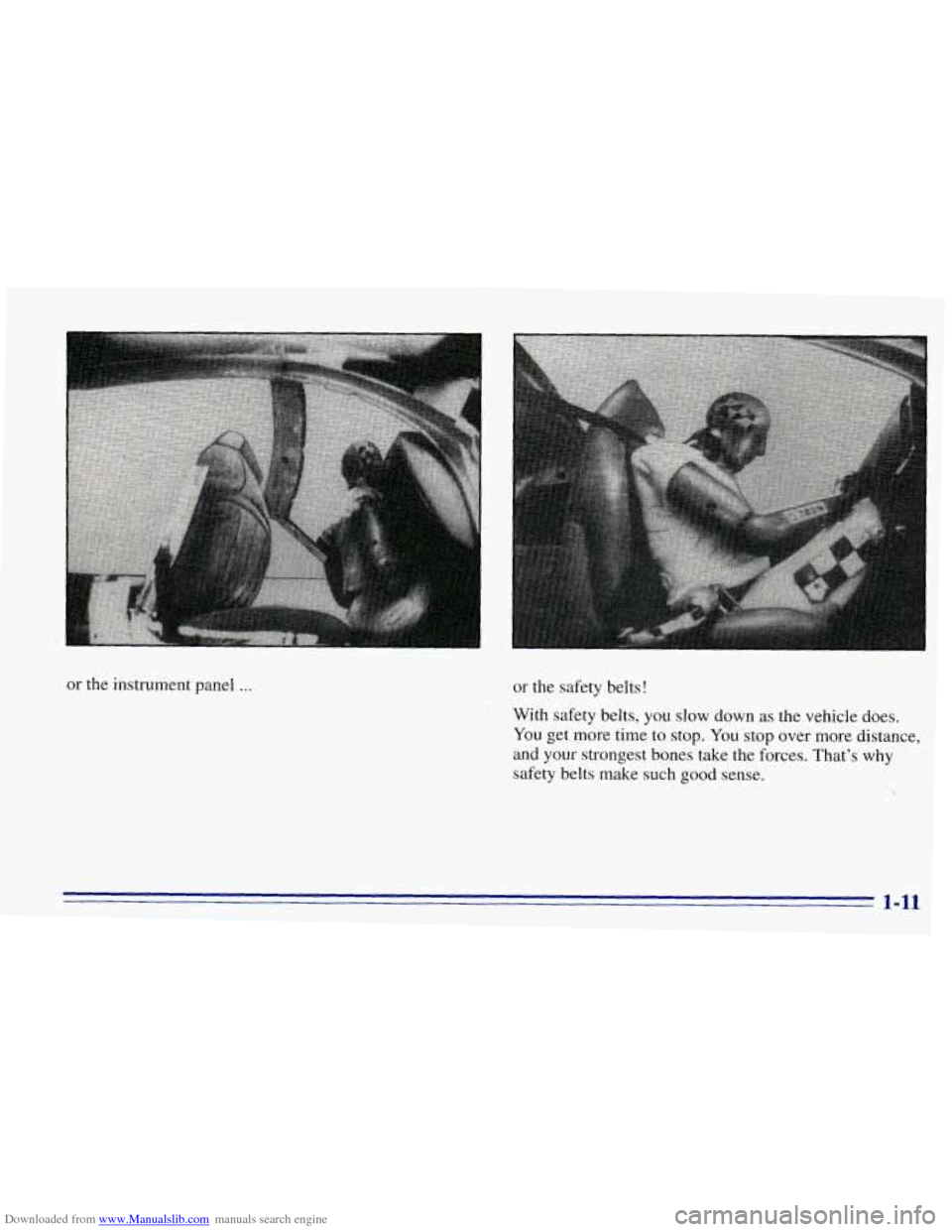
Downloaded from www.Manualslib.com manuals search engine J
or the instrument panel . . . or the safety belts!
With safety belts, you slow down as the vehicle does.
You get more time to stop. You stop over more distance,
and your strongest bones take the forces. That’s why
safety belts make such good sense.
1-11
Page 35 of 376
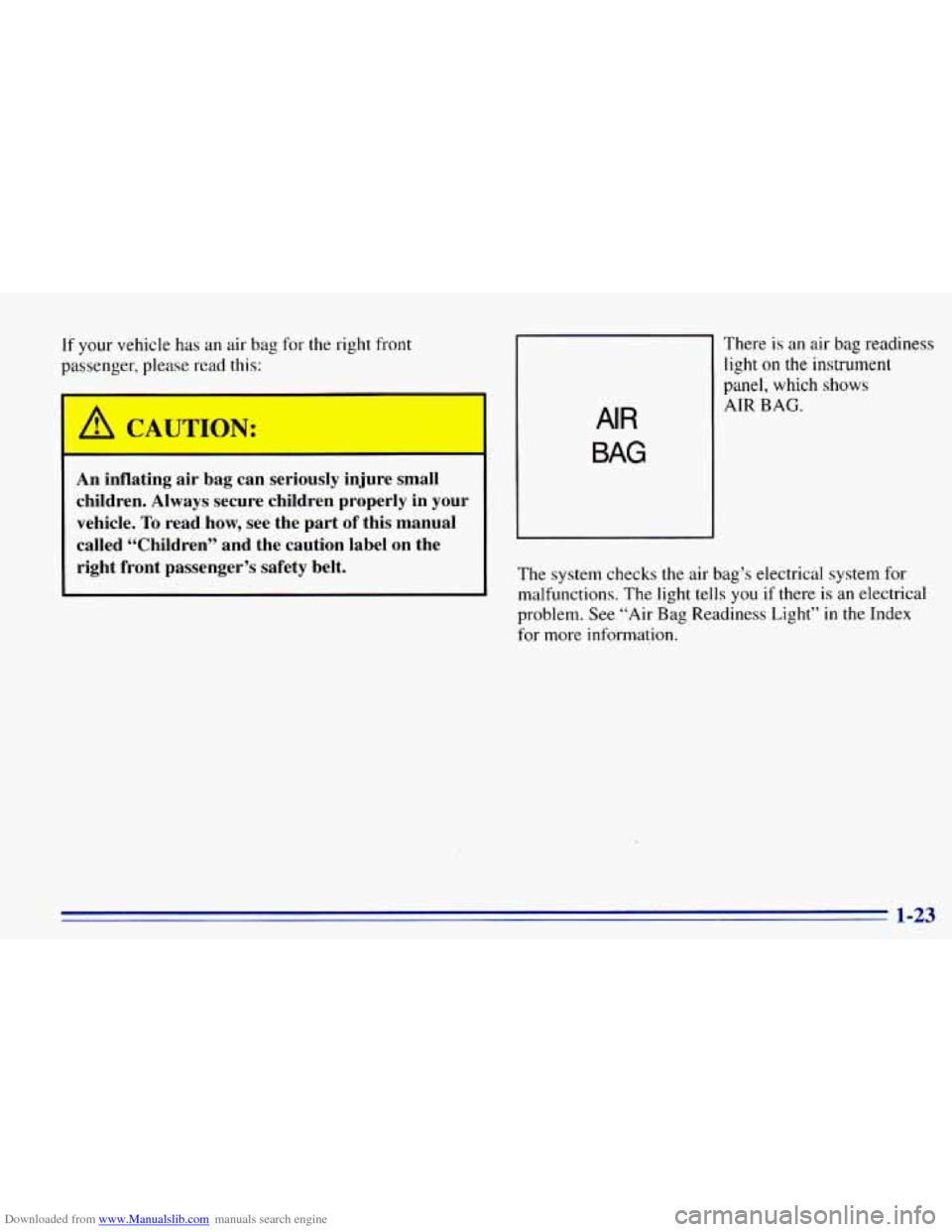
Downloaded from www.Manualslib.com manuals search engine If your vehicle has an air bag for the right front
passenger,
please read this:
A CAUTION:
r
An inflating air bag can seriously injure small
children. Always secure children properly in your
vehicle.
To read how, see the part of this manual
called “Children” and the caution label
on the
right front passenger’s safety belt.
AIR
BAG
There is an air bag readiness
light
on the instrument
panel, which shows
AIR BAG.
The system checks the air bag’s electrical system for
malfunctions. The light tells
you if there is an electrical
problem. See “Air
Bag Readiness Light” in the Index
for more information.
1-23
Page 36 of 376
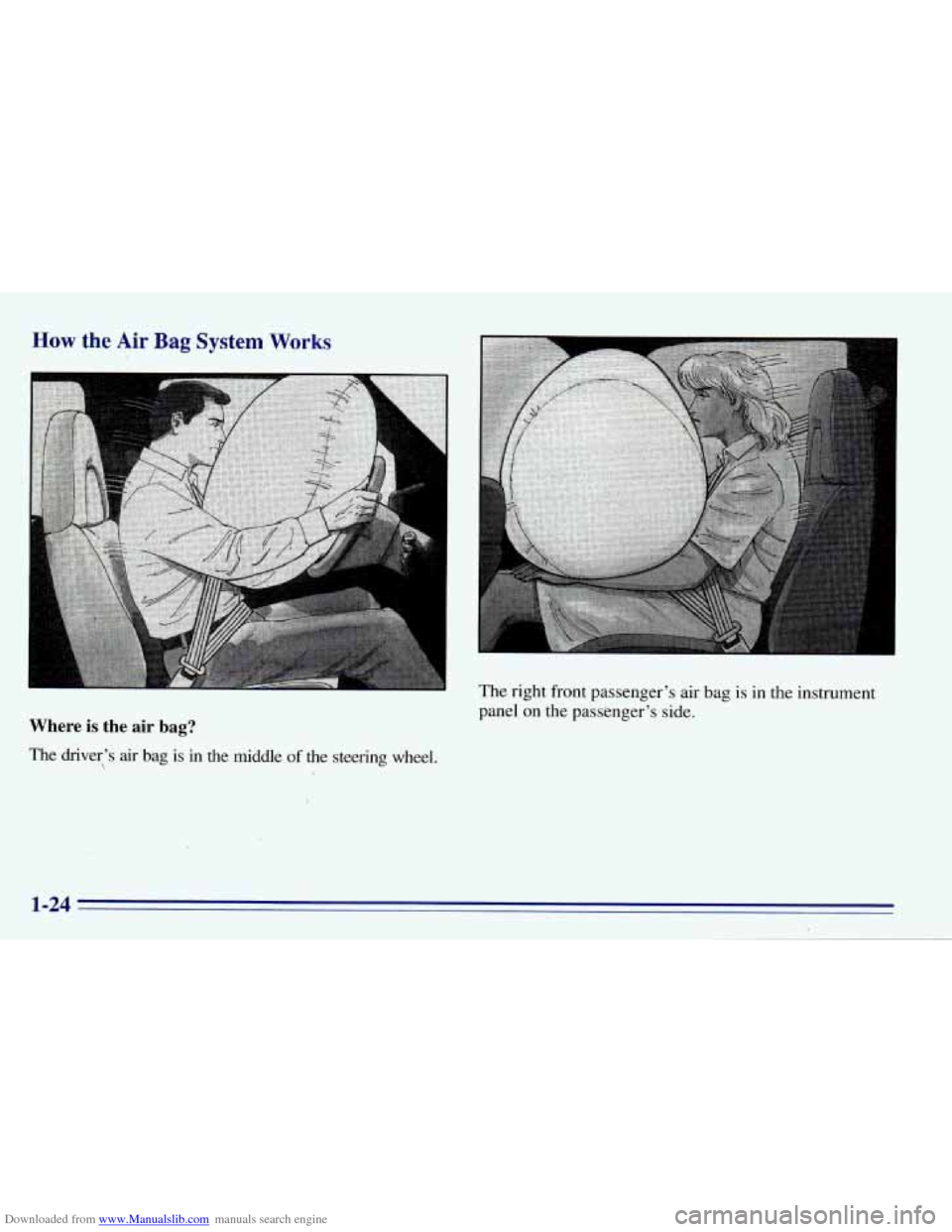
Downloaded from www.Manualslib.com manuals search engine How the Air Bag System Works
Where is the air bag?
The driver’s air bag is in the middle of the steering wheel. The
right front passenger’s air bag
is in the instrument
panel on the passenger’s side.
1-24
Page 37 of 376
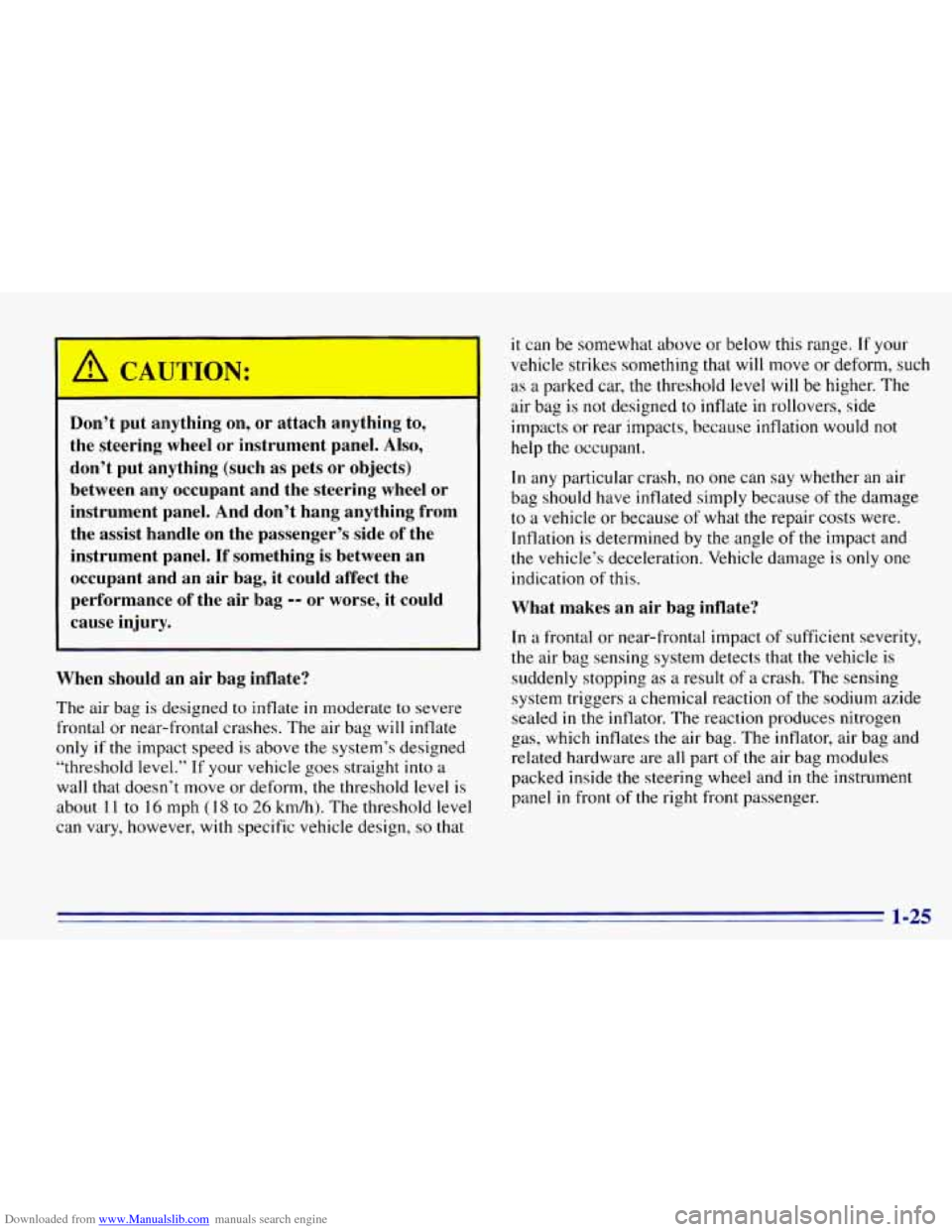
Downloaded from www.Manualslib.com manuals search engine Don’t put anything on, or attach anything to,
the steering wheel or instrument panel.
Also,
don’t put anything (such as pets or objects)
between any occupant and the steering wheel or
instrument panel. And don’t hang anything from
the assist handle on the passenger’s side of the
instrument panel.
If something is between an
occupant and an air bag, it could affect the
performance
of the air bag -- or worse, it could
cause injury.
When should
an air bag inflate?
The air bag is designed to inflate in moderate to severe
frontal or near-frontal crashes. The air bag will inflate
only if the impact speed is above the system’s designed
“threshold level.” If your vehicle goes straight into
a
wall that doesn’t move or deform, the threshold level is
about
1 1 to 16 mph (1 8 to 26 km/h). The threshold level
can vary, however, with specific vehicle design,
so that
it can be somewhat above or below this range. If your
vehicle strikes something that will move or deform, such
as
a parked car, the threshold level will be higher. The
air bag is not designed
to inflate in rollovers, side
impacts or rear impacts, because inflation would not
help
the occupant.
In any particular crash, no one can say whether an air
bag should have inflated simply because of the damage
to a vehicle or because of what the repair costs were.
Inflation is determined by the angle
of the impact and
the vehicle’s deceleration. Vehicle damage is only one
indication
of this.
What makes an air bag inflate?
In a frontal or near-frontal impact of sufficient severity,
the air bag sensing system detects that the vehicle is
suddenly stopping
as a result of a crash. The sensing
system triggers
a chemical reaction of the sodium azide
sealed
in the inflator. The reaction produces nitrogen
gas, which inflates the air bag. The inflator, air bag and
related hardware are all part
of the air bag modules
packed inside the steering wheel and
in the instrument
pane!
in front of the right front passenger.
1-25
Page 38 of 376
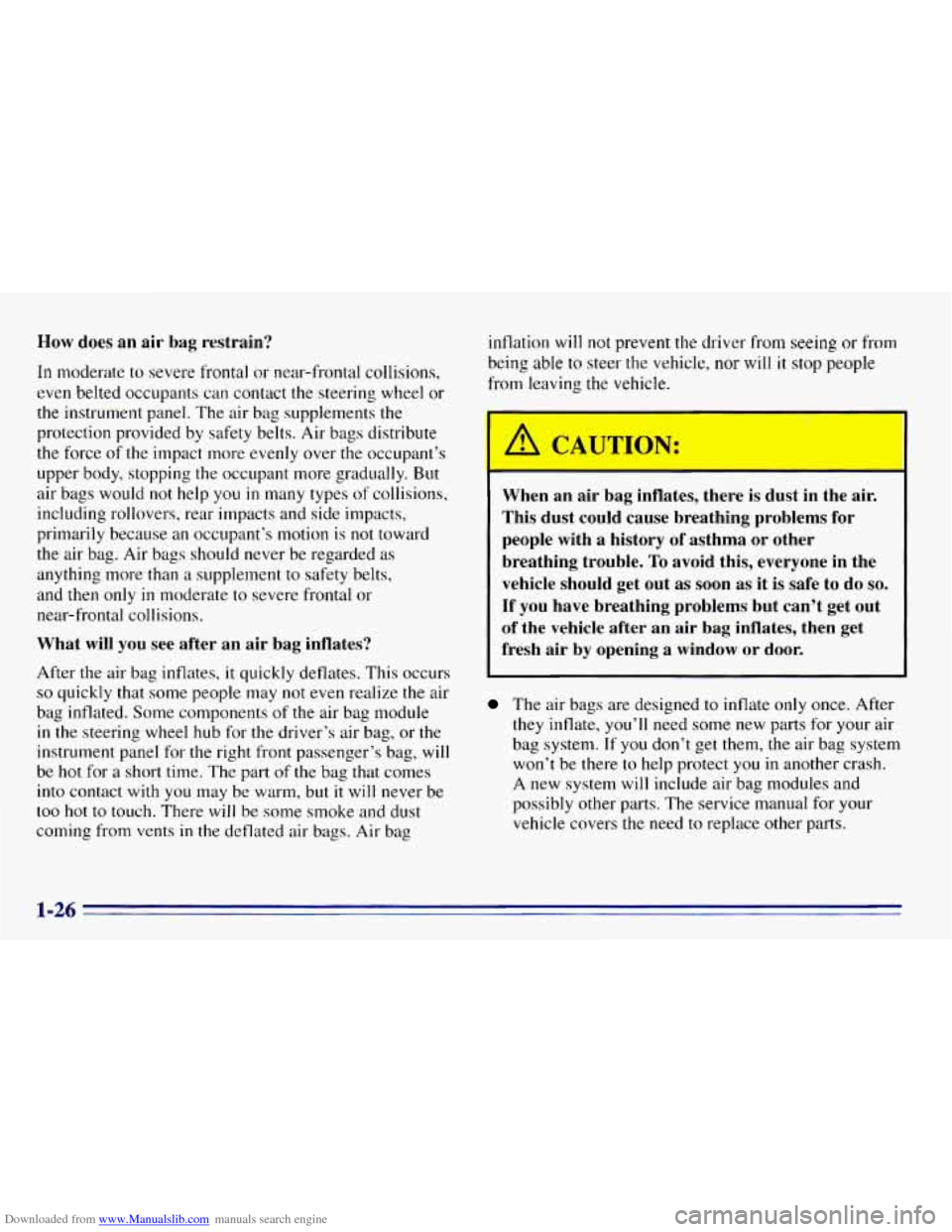
Downloaded from www.Manualslib.com manuals search engine How does an air bag restrain?
In moderate to severe frontal or near-frontal collisions,
even belted occupants can contact the steering wheel or
the instrument panel. The air bag supplements the
protection provided
by safety belts. Air bags distribute
the force
of the impact more evenly over the occupant’s
upper body, stopping the occupant more gradually.
But
air bags would not help you in many types of collisions,
including rollovers, rear impacts and side impacts,
primarily because
an occupant’s motion is not toward
the air bag. Air bags should never be regarded as
anything more than
a supplement to safety belts,
and then only
in moderate to severe frontal or
near-frontal collisions.
What will you see after an air bag inflates?
After the air bag inflates, it quickly deflates. This occurs
so quickly that some people may not even realize the air
bag inflated. Some components of the air bag module
in the steering wheel hub for the driver’s air bag, or the
instrument panel for the right front passenger’s bag, will
be
hot for a short time. The part of the bag that comes
into contact with you may be warm, but it will never be
too hot to touch. There will be some smoke and dust
coming from vents in the deflated air bags.
Air bag inflation
will
not prevent the driver from seeing or from
being able
to steer the vehicle, nor will it stop people
from leaving the vehicle.
r
-
When an air bag inflates, there is dust in the air.
This dust could cause breathing problems for
people with a history of asthma or other
breathing trouble.
To avoid this, everyone in the
vehicle should get out as soon as
it is safe to do so.
If you have breathing problems but can’t get out
of the vehicle after an air bag inflates, then get
fresh air by opening a window or door.
The air bags are designed to inflate only once. After
they inflate, you’ll need some new parts for
your air
bag system. If you don’t get them,
the air bag system
won’t be there
to help protect you in another crash.
A new system
will include air bag modules and
possibly other parts. The service manual for your
vehicle covers the need to replace other parts.
1-26
Page 39 of 376
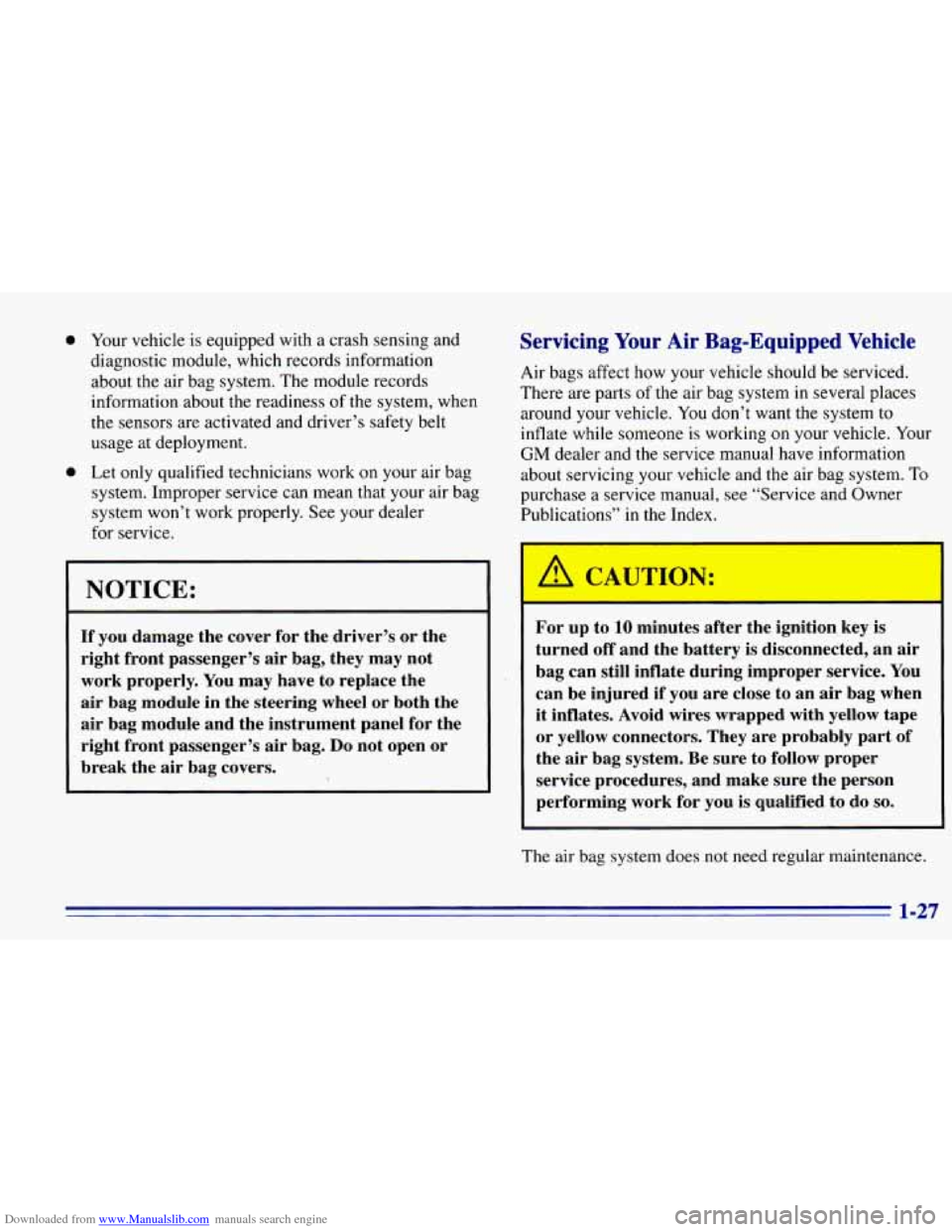
Downloaded from www.Manualslib.com manuals search engine 0
0
Your vehicle is equipped with a crash sensing and
diagnostic module, which records information
about the air bag system. The module records
information about the readiness of the system, when
the sensors are activated and driver’s safety belt
usage at deployment.
Let only qualified technicians work on your air bag
system. Improper service can mean that your air bag
system won’t work properly. See your dealer
for service.
NOTICE:
If you damage the cover for the driver’s or the
right front passenger’s
air bag, they may not
work properly. You may have
to replace the
air bag module in the steering wheel or both the
air bag module and the instrument panel for the
right front passenger’s
air bag. Do not open or
break the air bag covers.
Servicing Your Air Bag-Equipped Vehicle
Air bags affect how your vehicle should be serviced.
There are parts of the air bag system in several places
around your vehicle.
You don’t want the system to
inflate while someone is working on your vehicle. Your
GM dealer and the service manual have information
about servicing your vehicle and the air bag system.
To
purchase a service manual, see “Service and Owner
Publications” in the Index.
For up to 10 minutes after the ignition key is
turned
off and the battery is disconnected, an air
bag can still inflate during improper service. You
can be injured if you are close to an air bag when
it inflates. Avoid wires wrapped
with yellow tape
or yellow connectors. They are probably part of
the air bag system. Be sure to follow proper
service procedures, and make sure the person
performing work for
you is qualified to do so.
The air bag system does not need regular maintenance.
1 37
Page 63 of 376
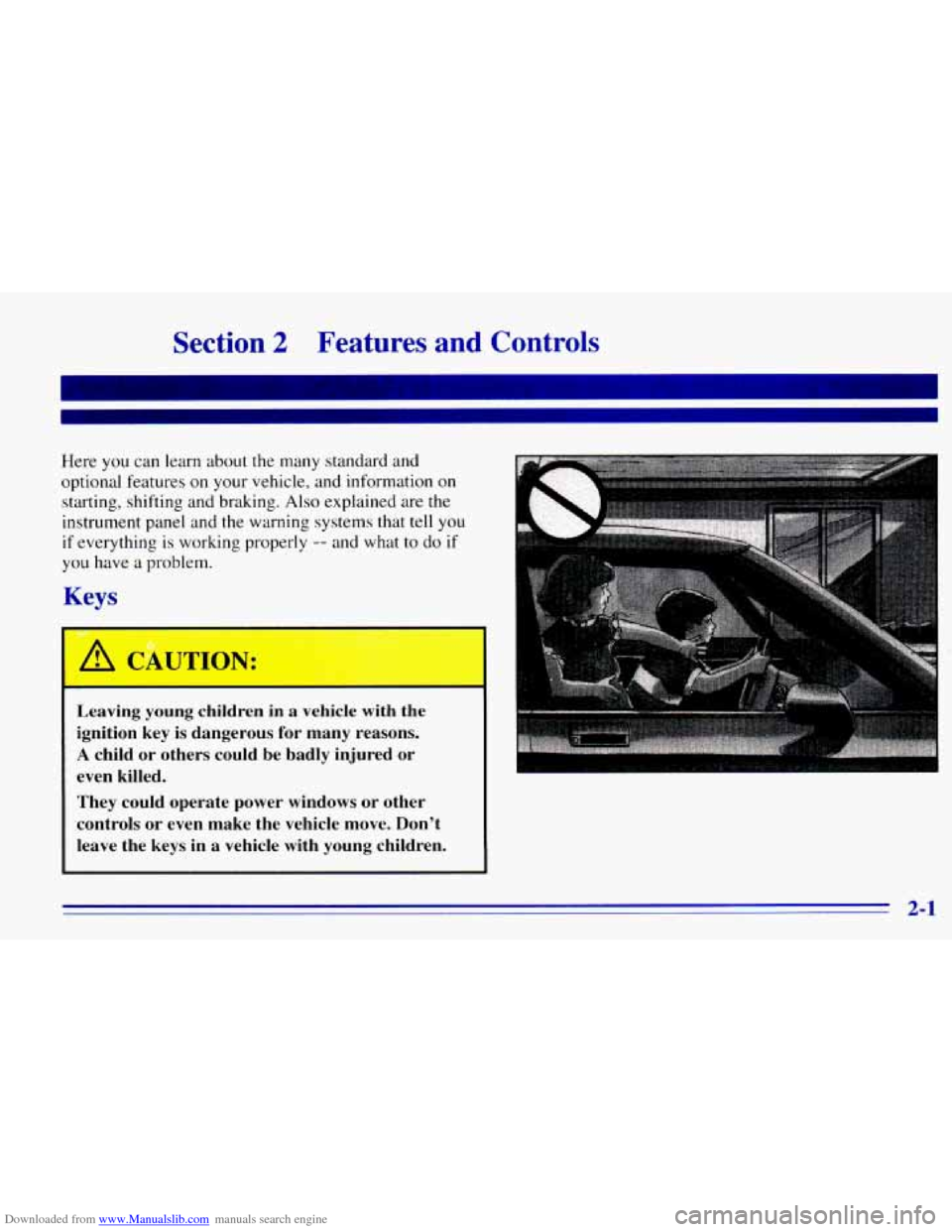
Downloaded from www.Manualslib.com manuals search engine Section 2 Features and Controls
Here you can learn about the many standard and
optional features
on your vehicle, and information on
starting, shifting and braking. Also explained are the
instrument panel and the warning systems that tell
you
if everything is working properly -- and what to do if
you have a problem.
Keys
Leaving young children in a vehicle with the
ignition key is dangerous for many reasons.
A child or others could be badly injured or
even killed.
They could operate power windows or other
controls or even make the vehicle move.
Don't
leave the keys in a vehicle with young children.
2-1
Page 73 of 376
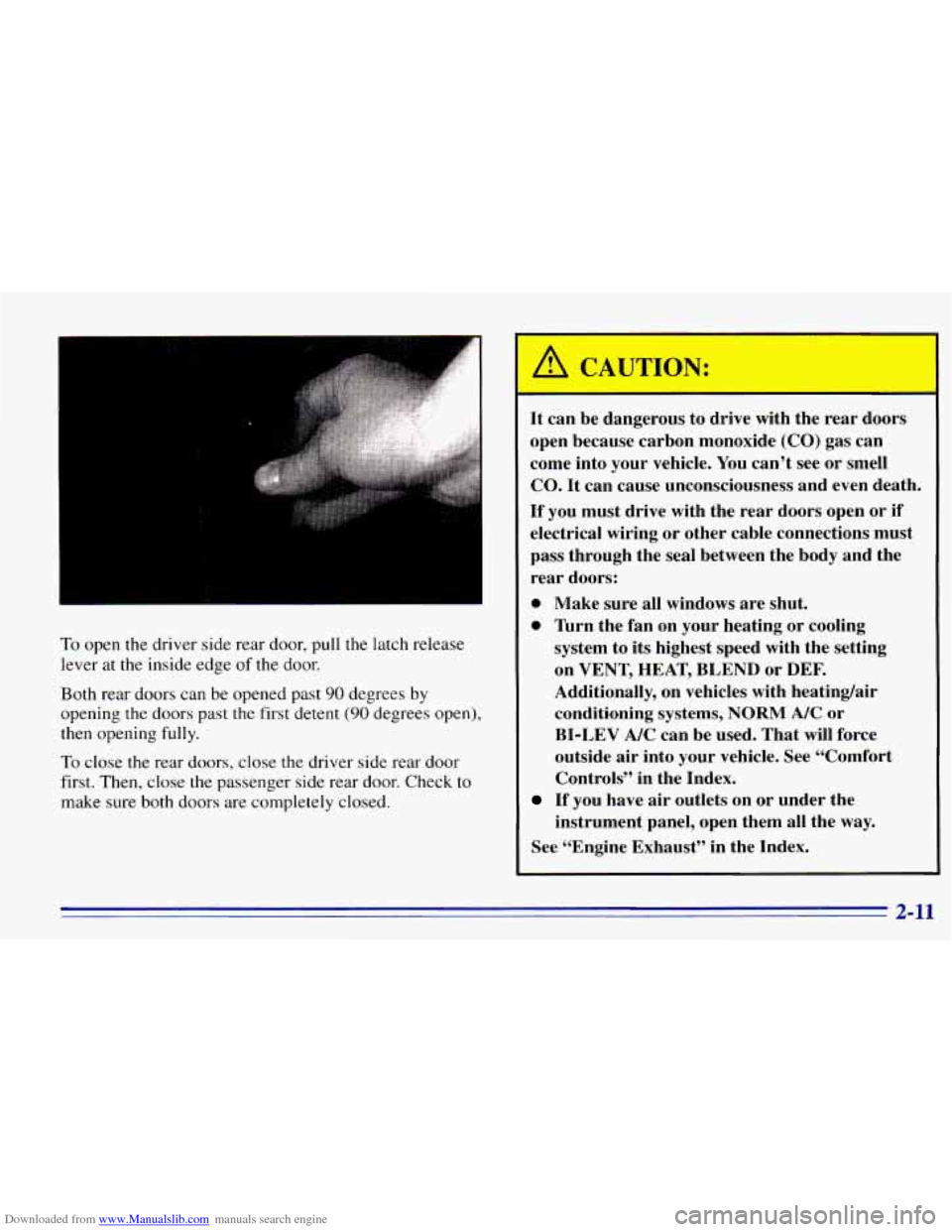
Downloaded from www.Manualslib.com manuals search engine To open the driver side rear door, pull the latch release
lever
at the inside edge of the door.
Both rear doors can be opened past
90 degrees by
opening
the doors past the first detent (90 degrees open),
then opening fully.
To close the rear doors, close the driver side rear door
first. Then, close the passenger side rear door. Check to
make sure both doors are completely closed.
A CAUTION:
It can be dangerous to drive with the rear doors
open because carbon monoxide (CO) gas can
come into your vehicle. You can’t see or smell
CO. It can cause unconsciousness and even death.
If you must drive with the rear doors open or if
electrical wiring or other cable connections must
pass through the seal between the body and the
rear doors:
0 Make sure all windows are shut.
0 lbrn the fan on your heating or cooling
system to its highest speed with the setting
on VENT, HEAT,
BLEND or DEF.
Additionally, on vehicles with heatinglair
conditioning systems,
NORM A/C or
BI-LEV A/C can be used. That will force
outside air into your vehicle. See “Comfort
Controls” in the Index.
instrument panel, open them all the way.
If you have air outlets on or under the
See “Engine Exhaust” in the Index.
2-11
Page 90 of 376
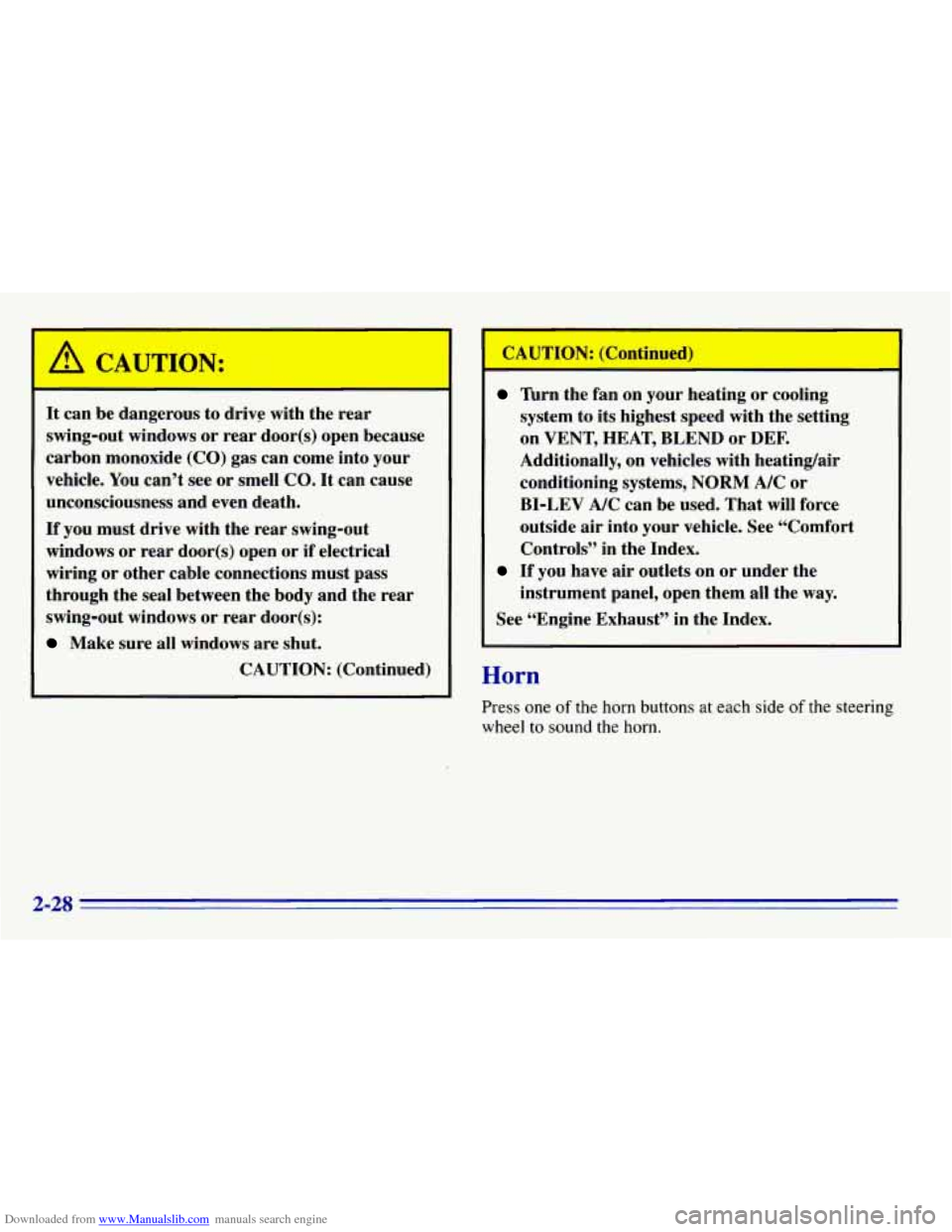
Downloaded from www.Manualslib.com manuals search engine CAUTION:
It can be dangerous to drive with the rear
swing-out windows or rear door(s) open because
carbon monoxide (CO) gas can come into your
vehicle. You can’t see or smell CO. It can cause
unconsciousness and even death.
If you must drive with the rear swing-out
windows or rear door(s) open or if electrical
wiring or other cable connections must pass
through the seal between the body and the rear
swing-out windows or rear door(s):
Make sure all windows are shut.
CAUTION: (Continued) CAUTION:
(Continued)
Turn the fan on your heating or cooling
system to its highest speed with the setting
on VENT, HEAT, BLEND or DEF.
Additionally, on vehicles with heatingair
conditioning systems, NORM A/C or
BI-LEV
A/C can be used. That will force
outside air into your vehicle. See “Comfort
Controls” in the Index.
instrument panel, open them all the way.
If you have air outlets on or under the
See “Engine Exhaust” in the Index.
Horn
Press one of the horn buttons at each side of the steering
wheel to sound the horn.
2-28
Page 92 of 376
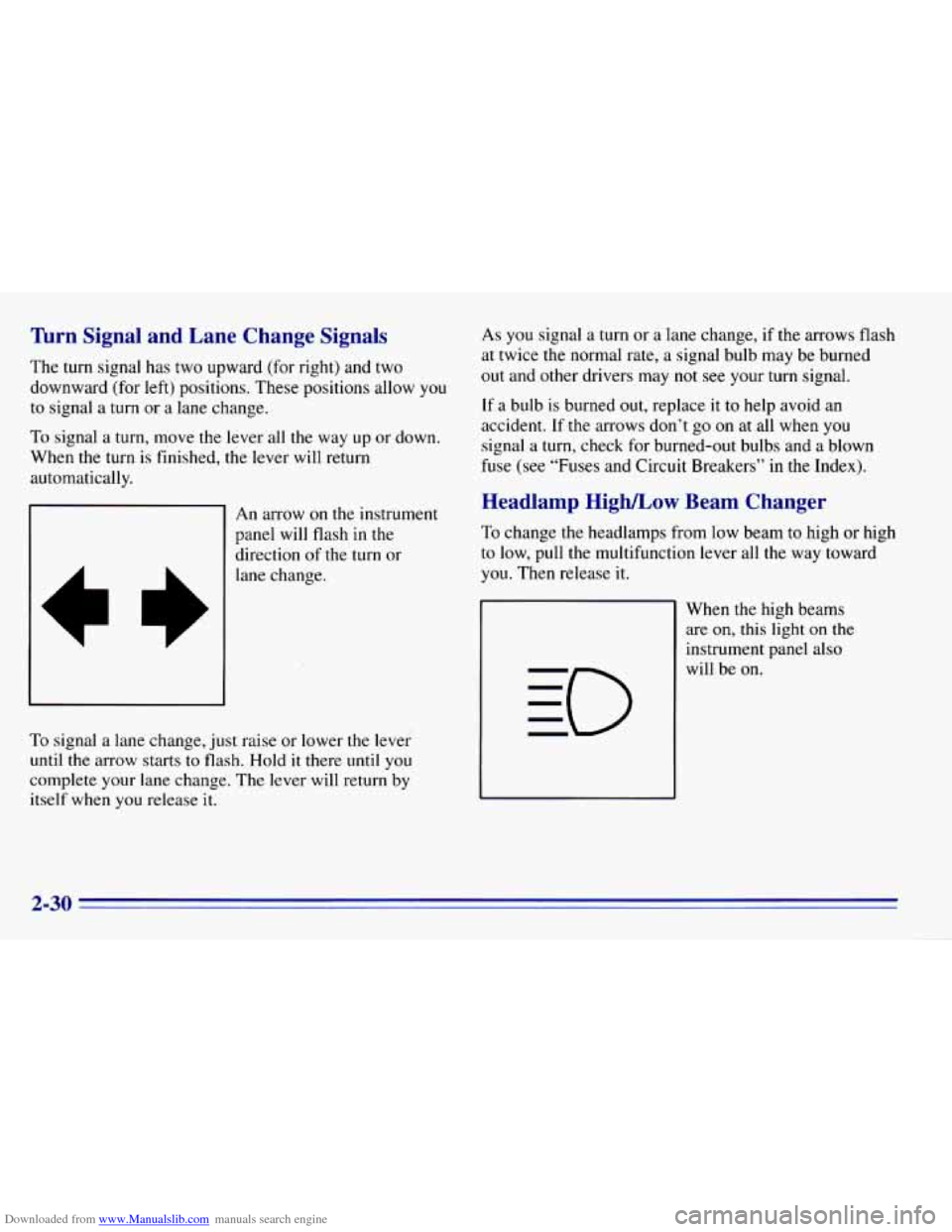
Downloaded from www.Manualslib.com manuals search engine ’hrn Signal and Lane Change Signals
The turn signal has two upward (for right) and two
downward (for left) positions. These positions allow
you
to signal a turn or a lane change.
To signal
a turn, move the lever all the way up or down.
When the turn is finished, the lever will return
automatically.
An arrow on the instrument
panel will flash in the
direction of the turn or
lane change.
To signal a lane change, just raise or lower the lever
until
the arrow starts to flash. Hold it there until you
complete your lane change. The lever will return by
itself when
you release it. As
you signal
a turn or a lane change, if the arrows flash
at twice the normal rate, a signal bulb may be burned
out and other drivers may not see your turn signal.
If a bulb is burned out, replace it to help avoid an
accident. If.the arrows don’t go on at all when
you
signal a turn, check for burned-out bulbs and a blown
fuse (see “Fuses and Circuit Breakers” in the Index).
Headlamp High/Low Beam Changer
To change the headlamps from low beam to high or high
to low, pull the multifunction lever all the way toward
you. Then release it.
When the high beams are
on, this light on the
instrument panel also
will be on.
2-30
.-